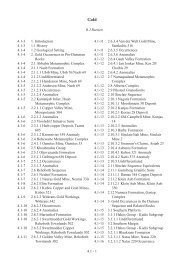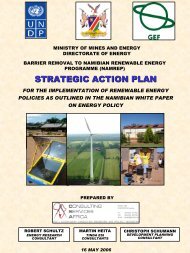Solar PV water pumping study - FINAL REPORT ... - UNDP, Namibia
Solar PV water pumping study - FINAL REPORT ... - UNDP, Namibia
Solar PV water pumping study - FINAL REPORT ... - UNDP, Namibia
Create successful ePaper yourself
Turn your PDF publications into a flip-book with our unique Google optimized e-Paper software.
Feasibility Assessment for the Replacement of Diesel Pumps with <strong>Solar</strong> Pumps<br />
5 CONCLUSION<br />
<strong>FINAL</strong> <strong>REPORT</strong>: September 2006<br />
The <strong>study</strong> shows that <strong>Namibia</strong>n <strong>water</strong> supply needs stand to benefit from converting to solar<br />
<strong>PV</strong> <strong>water</strong> <strong>pumping</strong> in cases where:<br />
• Water depth is less than 120m and the hydraulic load is less than 4,000m 4 /day.<br />
• Water depth is less than 200m and the hydraulic load is less than 500m 4 /day.<br />
The years to breakeven between <strong>PV</strong>P and DP systems are:<br />
• With immediate effect for <strong>PV</strong>Ps operating below 250m 4 /day,<br />
• Less than one year for <strong>PV</strong>Ps operating below 500m 4 /day,<br />
• Less than 2.5 years for <strong>PV</strong>Ps operating below 1,000m 4 /day,<br />
• Less than 6 years for <strong>PV</strong>Ps operating below 2,000m 4 /day, and<br />
• Less than 8 years for <strong>PV</strong>Ps operating below 4,000m 4 /day and below 120m head.<br />
General application issues result in exceptions such as, for example:<br />
• where the <strong>water</strong> requirements are seasonal or<br />
• where the diesel engine/generator has a multifunction use, e.g. at a farming<br />
homestead or<br />
• where the diesel engine must be moved to other boreholes at various intervals or<br />
• where a fully operational wind pump is backed-up by a diesel engine/generator, it is<br />
unlikely that the <strong>PV</strong>P option will present a viable alternative.<br />
The main barriers identified are:<br />
• Theft is probably the single largest barrier to widespread use of <strong>PV</strong>Ps. The bulk of the<br />
capital cost of a <strong>PV</strong>P system rests in the photovoltaic modules which are often<br />
difficult to protect. In a diesel <strong>water</strong> <strong>pumping</strong> system the majority of the cost goes into<br />
infrastructure development and heavy materials (foundations, rising main pipes,<br />
element).<br />
• The second major barriers to use of <strong>PV</strong>Ps are perceptions that the cost of solar <strong>PV</strong><br />
<strong>water</strong> <strong>pumping</strong> is higher than diesel <strong>water</strong> pumps.<br />
• Dependence on specialised services which are possibly only available in Windhoek -<br />
or discomfort with the technology (high tech). Support for the diesel engine is either<br />
locally available or in the vicinity – that gives users a higher <strong>water</strong> supply security.<br />
• Many users perceive the <strong>PV</strong>P option to be inflexible to fluctuating <strong>water</strong> demands and<br />
seasonal variations and are therefore not aware of hybrid options for <strong>PV</strong>P (users are<br />
aware of the hybrid option between wind and diesel).<br />
The key findings of this <strong>study</strong> are:<br />
• Technology developments have now provided products which can be described as<br />
the optimal system for the average borehole conditions:<br />
Page 47 of 76




